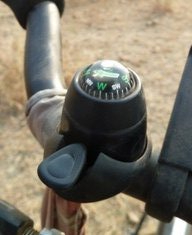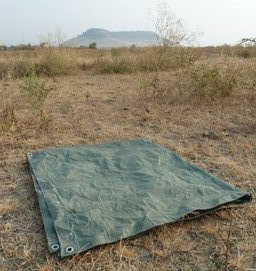A bunch of tips and experience that I’ve gathered after several years on the road
The Bicycle Touring Tent
There is no such thing as the perfect tent: A mountaineering tent needs different properties then a hiking tent which again is different from a big comfortable tent that you take fishing and transport in a car.

In my opinion, this is what you should look for in a bicycle touring tent:
a) Free-standing design: You will be camping many weird places where it could be very difficult to get your stakes in the ground (because of solid, dry mud or because you are camping on concrete behind a factory or among the sheeps at a Peruvian farm). Therefore, get a tent that doesn’t need stakes in order to pitch. Clearly, all tents are more stable with stakes, but if it isn’t raining or very windy, a free-standing tent doesn’t really need stakes, you merely have the tent for a bit of shelter and to keep bugs away.
b) Pitch the inner-tent only: If you’ll be camping in hot, tropical or desert areas, the tent will get unbearable warm as the sun rises and starts to bake your tent: the fly will cause a greenhouse-effect and you’ll be drained in sweat in no-time. If you can pitch the inner-tent only, it will provide much better ventilation and you’ll get another hour of sleep. Of course, if there is a chance of rain, this advice is irrelevant, but there surely are some huge dry areas of the world where rain just doesn’t happen for some months.
c) Color: Greenish. As you might often be “stealth-camping” in unofficial places, it is a good thing if you tent blends in with the surroundings, in order to hide a bit. Avoid bright orange etc.
d) Size and weight: As you will be cycling with your tent, you probably want a tent that is not too heavy. But be careful about the super-lightweight 800g tents, I’ve seen how fragile they are in windy conditions.
e) A strong floor: Again, as you will likely be camping in unofficial places, don’t expect to find a nice manicured lawn to pitch your tent on. Instead, often you’ll have branches and stones under your tent and hence a good quality tent-floor is important. The super-lightweight tents, again, are a bit vulnerable in this category.
Rear View Mirror
For your safety and your comfort, I highly recommend mounting a rear view mirror on your handlebar (or even on your helmet).
Handlebar comfort
The comfort of your hands, arms and back will determine how pleasurable your bicycle tour will be. You need a comfortable handlebar with several different hand-positions and preferable an option for an upright position.
Consider mounting some large bar-ends to facilitate a nice upright position in order to stretch your back and relax your hands. Sure, your handle-bar will look weird, but who cares ?
Wheels
If you plan to cycle on lots of gravel roads, you will need some good quality, strong wheels: Strong spokes and rim. I have 36 spokes on my front wheel and 40 spokes on the back wheel and my wheels are still true after 40.000+ km through 30 countries, I’ve only broken a spoke once. If you are a big, tall guy of 90 kg (200 lbs), this gets even more important. Strongly consider your choice of wheels, it is the most vulnerable part on your bicycle, and leads to a lot of headaches if they break in some rural area of a developed country without access to spareparts.
26 inch or 700mm wheel size? An ongoing discussion among all bicycle- tourers.
26 inch are probably a bit stronger since the “circle” is smaller. Outside of the developed world you also have much better access to spare-parts like spokes, rim, tubes and tires if you roll on 26 inch wheels as this tend to be the standard. It is said that 700mm wheels are slightly faster than the 26 inch, due to the larger circumference. Some people also claim that they “roll better” and are more comfortable to ride on.
Personally, I have 700mm on my bicycle and I am very happy with them. However, I haven’t had any major wheel break-downs in developing countries and I am sure I would wish I had 26 inch if that were to happen. When all is said and done, I’d probably get 26inch if I were to re-purchase my bicycle.
A front kick-stand
A kickstand is a very nice feature, as you can park your bicycle everywhere easily with access to your panniers, without laying it down or looking for something to lean it on. However, when you only have a rear-kickstand, it receives the entire load: I’ve met dozens of tourers who have broken the bolts on their rear-kickstand.
A front kickstand solves this problem: the load is distributed and you avoid the “dynamic load” when your front-wheel turns and the whole bicycle swings, adding a huge load on the rear-kickstand. The Tubus front-rack have the option of adding this front-kickstand, I haven’t seen other alternatives. If you have a Tubus front-rack, get the front kickstand as well. (Anyways, the Tubus racks are also highly recommended: they are expensive but of very high quality, I haven’t met anybody who’ve broken their Tubus racks)

Tripod for photos (telescopic)
You can start composing some really nice shots if you carry a tripod: Of your camp in the sunset or catch the atmosphere when you are cycling through stunning scenery.
It doesn’t have to be too bulky or heavy, get a telescopic tripod that easily packs into your front panniers.
Fold your spare tire… and strap it !
It can be difficult to find good touring tires that are foldable, especially when you are on the road in developing countries. So if you want to cycle with a spare tire, fold it up in a figure-8 and tie it with plastic straps to keep it from unfolding.
If you don’t tie it with the plastic straps but keep folding it every morning that you pack your bike, you will quickly damage the tire and the wiring inside it: the plastic straps are essential to avoid this damage.

Dog-stick
Many places in the world, you’ll have dogs chasing you, especially in developing countries. Often they just want to play or mark their territory, but some regions they get super aggressive and will attempt to bite you and your panniers.
In Peru I had enough and duct-taped a plastic-bottle onto my front-rack in order to cycle with a stick. The dogs are clearly afraid when I raise my “sword” like a knight on a horse. And, when attacked, I have no moral problems with defending myself and smacking the aggressive dogs, if necessary.
But be careful of how you mount the stick in the plastic-bottle, you don’t want it to jump out of the bottle and into your front wheel while cycling.

Compass Bell
Neat little tool, follow your progress on the maps, monitor the wind direction and never get lost at a crossroad. Once you have it, you’ll love it.
The bell itself makes a weak sound and doesn’t command much respect in the chaotic traffic on our planet.
Sure, you can look at the sun, but if it is cloudy you’ll be a bit confused. And let’s be honest, looking at the sun is not a very precise method.

Carry a tarp
I carry a 1.2m x 2.4m thin, lightweight tarp, I think it is around 300g and costs 4 USD in a your local hardware store.
When camping in sand, it makes for a wonderful carpet when cooking and chilling. If it is raining, you can fairly easily make a rain-shelter by tying it from your tent to your bike. And if there are lots of branches and sharp stones it makes for a good protective footprint underneath your tent to not damage your tent-floor or puncture your mattress inside.
Lots of uses and unless you are a weight-freak, you’ll love it.



